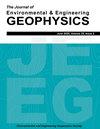The Whole-Space Modeling of the Hazardous Geological Body ahead of the Tunnel Face by the Transient Electromagnetic Method
IF 0.7
4区 工程技术
Q4 ENGINEERING, GEOLOGICAL
引用次数: 0
Abstract
Karst caves are widely distributed in southwest China, causing difficulties and disasters for tunnel construction. To better detect the krast caves in front of the tunnels under construction using the transient electromagnetic method, in this paper we propose a 3-D finite element method to simulate the multi-parameter transient electromagnetic response of unfavorable geological bodies in a whole-space. First, the models of vertical water-filled faults, water-filled caves and complex geological bodies in front of the tunnel face are established. The horizontal electric field component and the vertical magnetic field component at different time in the whole-space are researched. Secondly, the electromagnetic response features of the caves with different resistivity, buried depths and scales are studied. We found that the resistivity of the target body is 10 times larger than that of the surrounding rocks, and the anomaly amplitude increases obviously with the growing distance from the target body. The deeper the buried depth, the later the anomaly appears and the smaller the anomaly amplitude. The larger the target size, the longer the transient electromagnetic response delay and the larger the anomaly amplitude. We arranged a measuring line on the tunnel face. The full-time apparent resistivity section shows the position and characteristics of the low-resistivity anomalous body, indicating that the transient electromagnetic method (TEM) has obvious advantages in detecting the low-resistivity body in front of the tunnel face. Finally, the TEM is successfully applied to the advanced detection of a karst tunnel to get the electrical distribution of the surrounding rocks in front of the tunnel face. According to the geological conditions of the excavated tunnel, the validity of the TEM in the tunnel advanced prediction is verified.巷道工作面前方危险地质体瞬变电磁法全空间建模
中国西南地区溶洞分布广泛,给隧道建设带来了困难和灾害。为了更好地利用瞬变电磁法探测正在施工的隧道前方的岩溶洞,本文提出了一种三维有限元方法,在全空间内模拟不利地质体的多参数瞬变电磁响应。首先,建立了巷道前方垂直充水断裂、充水溶洞和复杂地质体模型;研究了整个空间中不同时刻的水平电场分量和垂直磁场分量。其次,研究了不同电阻率、埋深和不同规模岩洞的电磁响应特征。结果表明,靶体的电阻率比围岩大10倍,且异常幅度随距靶体距离的增加而明显增大。埋深越深,异常出现越晚,异常幅度越小。目标尺寸越大,瞬变电磁响应延迟越长,异常幅度越大。我们在隧道工作面布置了测量线。全时视电阻率剖面显示了低阻异常体的位置和特征,表明瞬变电磁法在探测巷道前方低阻异常体方面具有明显优势。最后,成功地将瞬变电磁法应用于某岩溶隧道超前探测中,获得了隧道工作面前方围岩的电性分布。根据开挖隧道的地质条件,验证了瞬变电磁法在隧道超前预测中的有效性。
本文章由计算机程序翻译,如有差异,请以英文原文为准。
求助全文
约1分钟内获得全文
求助全文
来源期刊

Journal of Environmental and Engineering Geophysics
地学-地球化学与地球物理
CiteScore
2.70
自引率
0.00%
发文量
13
审稿时长
6 months
期刊介绍:
The JEEG (ISSN 1083-1363) is the peer-reviewed journal of the Environmental and Engineering Geophysical Society (EEGS). JEEG welcomes manuscripts on new developments in near-surface geophysics applied to environmental, engineering, and mining issues, as well as novel near-surface geophysics case histories and descriptions of new hardware aimed at the near-surface geophysics community.
 求助内容:
求助内容: 应助结果提醒方式:
应助结果提醒方式:


